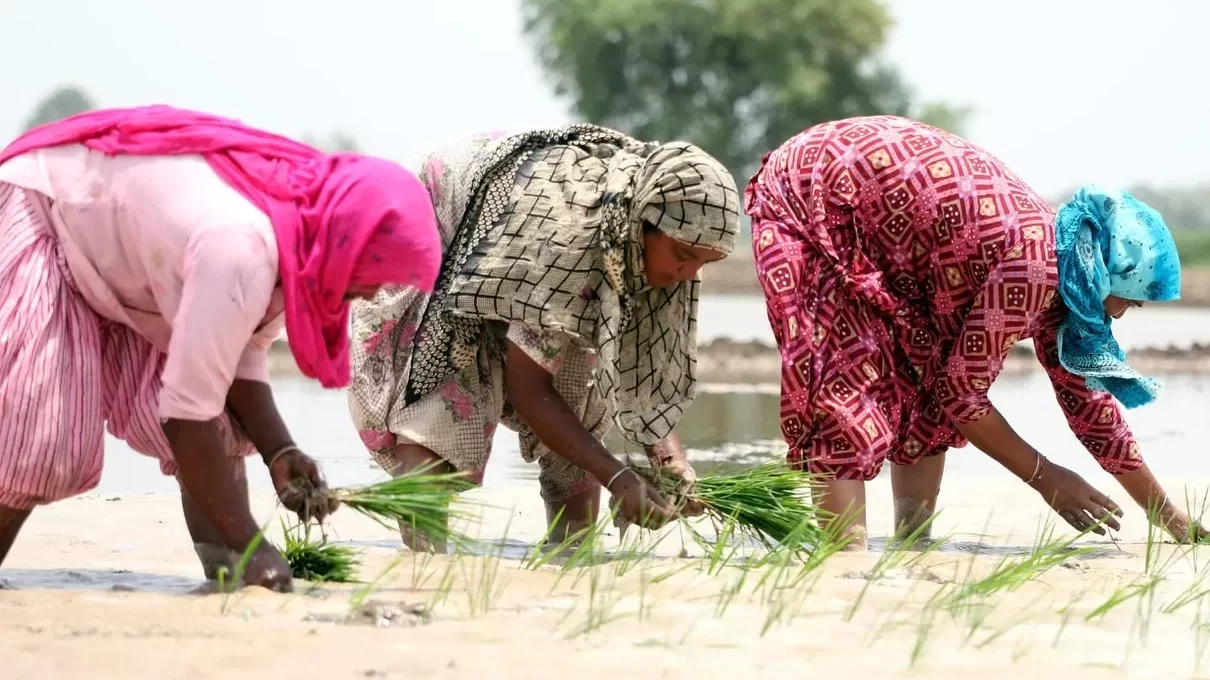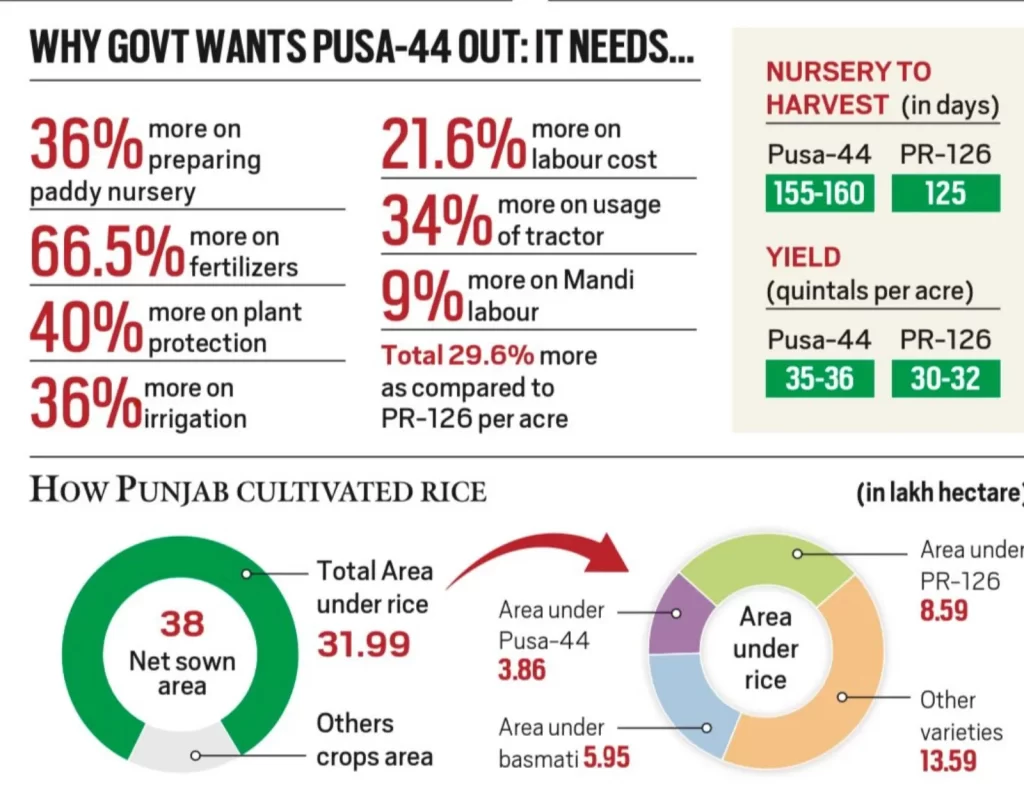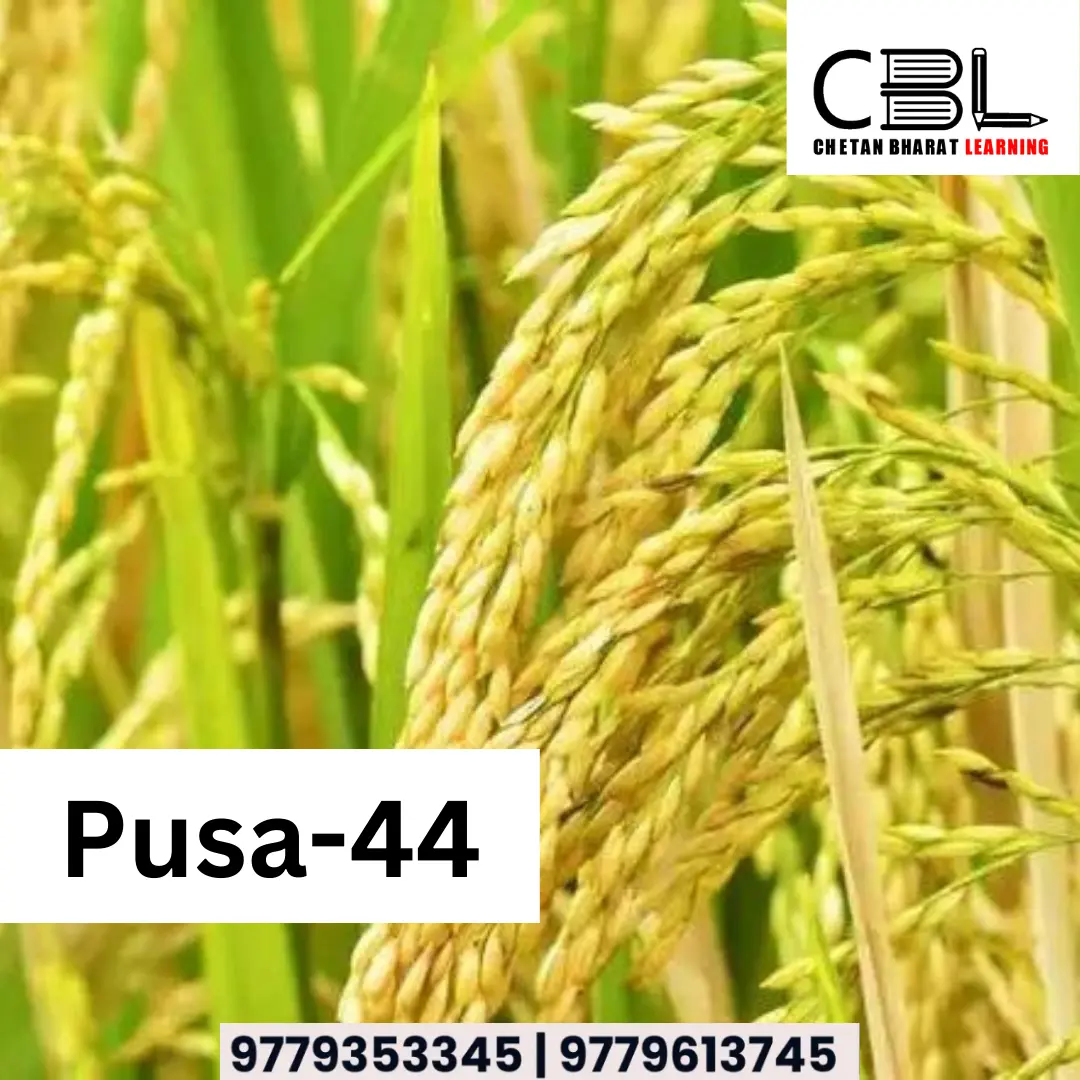About Pusa-44
- PUSA-44 is a paddy variety, developed in 1993 by the Indian Council of Agricultural Research (ICAR).
- By the late 2010s, it had become highly favoured among Punjab farmers. It accounted for about 70 to 80% of the paddy cultivation area.
- Farmers report impressive yields with PUSA-44, ranging from 85 to 100 mann (equivalent to 34 to 40 quintals) per acre. This surpassed the average yield of other varieties, which typically range from 28 to 30 quintals per acre.

Concerns regarding Pusa-44
- As a long-duration variety, it requires approximately 160 days to reach maturity. The period is significantly longer than other varieties by about 35 to 40 days.
- Its extended growth period demands an additional 5-6 cycles of irrigation compared to shorter-duration varieties.
- To address Punjab’s critical groundwater depletion and promote the adoption of short-duration paddy varieties, the government plans to prohibit this variety, It aims to conserve one month’s worth of irrigation water.
- Furthermore, this variety exacerbates the longstanding issue of stubble burning in the state.
- Cultivating this variety on a large scale results in approximately 2% more stubble compared to shorter varieties, posing a significant concern.

Pusa-2090: A Potential Solution
- IARI introduces Pusa-2090, an upgraded variant bred from a hybridization of Pusa-44 and CB-501, a Japonica rice strain known for early maturation.
- Maturing in a significantly shorter timeframe of 120-125 days, Pusa-2090 maintains comparable yields, effectively tackling the stubble burning issue.
- By combining the high yield characteristics of Pusa-44 with the rapid maturation cycle of CB-501, Pusa-2090 emerges as a viable substitute.
- Extensively evaluated by the All-India Coordinated Rice Improvement Project, Pusa-2090 has been earmarked for cultivation in regions like Delhi and Odisha.
- Farmers in test regions have reported encouraging yield outcomes from Pusa-2090 cultivation.
What is Stubble Burning?
- Stubble burning involves igniting the leftover straw stubble after harvesting crops such as paddy and wheat.
- In India, this practice, known as stubble or “parali” burning, is carried out primarily to clear paddy crop residues from fields before sowing wheat, typically occurring from late September to early November.
- The practice is widespread, particularly in states like Punjab, Haryana, and Uttar Pradesh during the months of October and November.

Ill Effects of Stubble Burning
- Stubble burning releases harmful gases like Carbon Monoxide (CO), Methane (CH4), Polycyclic Aromatic Hydrocarbons (PAH), and Volatile Organic Compounds (VOC), contributing to the formation of a dense smog layer that deteriorates air quality and poses health risks, particularly in Delhi.
- Elevated soil temperatures caused by burning residues result in the demise of beneficial soil organisms, leading to a decline in microbial populations and reduced levels of Nitrogen and Carbon in the soil, essential for crop root development.
- Health impacts of air pollution range from skin irritation to severe neurological, cardiovascular, and respiratory disorders. Studies indicate a significant reduction in life expectancy for Delhi residents, decreasing by approximately 6.4 years due to heightened pollution levels.
- Inadequate stubble management infrastructure prompts farmers to resort to burning, with nearly 15.4 million metric tons (out of 19.7 MMT) burned in open fields in Punjab in 2017. This practice is preferred due to its cost-effectiveness and efficiency in land clearance for the next cropping season.
- Agricultural subsidies, including those for electricity, fertilisers, and credit accessibility, have contributed to substantial increases in crop yields and productivity, exacerbating stubble burning in subsequent years.
Alternatives to Stubble Burning
- The Indian Agriculture Research Institute has developed a bio-enzyme named PUSA. Pusa, upon application, initiates stubble decomposition within 20-25 days. It transforms it into fertilizer that enriches soil health and increases organic carbon content. Thus, consequently reducing fertilizer expenses for subsequent crop cycles.
- Palletisation – paddy straw is dried and converted into pellets that can be mixed with coal for use in thermal power plants and industries. This would help in conserving coal and mitigating carbon emissions.
- The Happy Seeder is a tractor-mounted device. It facilitates cutting and lifting rice straw, sowing wheat, and depositing straw over the sown area as mulch.
- The Chhattisgarh government’s innovative approach involves establishing gauthans, five-acre plots owned by each village, where stubble is collected through donations and converted into organic fertiliser by mixing cow dung with natural enzymes.
- Moreover, stubble can be utilised as cattle feed, compost manure, roofing material in rural areas, packaging material, paper production, and bioethanol preparation.
- Recent research indicates that adopting new and improved seed varieties could serve as a solution to stubble burning. These varieties are short-duration options like Pusa Basmati-1509 and PR-126 for rice and wheat. These varieties mature rapidly and enhance soil quality.
- Besides introducing better seed varieties, promoting farmer awareness and behavioral change is crucial. Educating farmers about the hazards of stubble burning to both human health and soil fertility is essential. Encouraging them to embrace eco-friendly technologies is vital.


Leave a Reply
You must be logged in to post a comment.